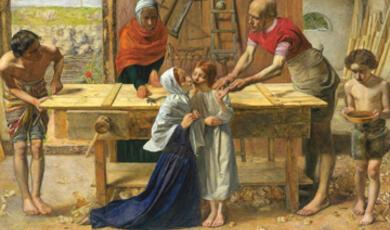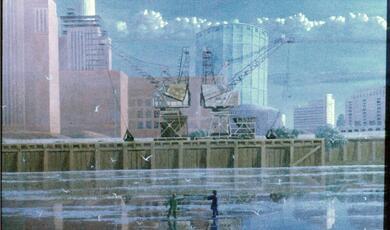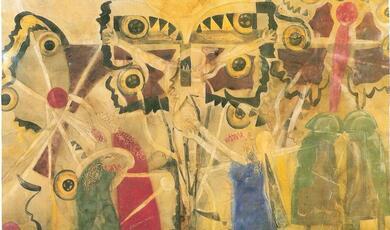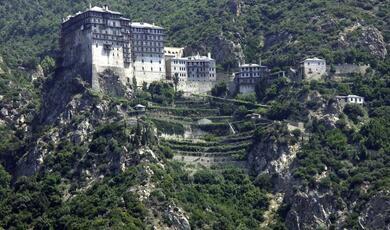30 March 2012
Thinking Theologically about Modern Art:
Marching to an Antique Drum?
Roger Wagner
This is a picture of a window in Iffley church in Oxford, for which almost three years ago, I was asked to design and make some stained glass. As the first church commission I’d ever undertaken, and the first stained glass I had ever made, it was a daunting prospect. Daunting, not only because the window would have to stand opposite one of John Piper’s finest windows, but because of the setting in which it would be placed. A painting may stand as a free work of the imagination, but a window must relate to what is already there. It may enhance or detract, complement or contradict, but whatever it does it will not stand alone. It will have a clear and explicit relationship with the past.
Richard has asked us today to think theologically about modern art, and in trying to do so it is the nature of art’s relationship with its past that I want to focus on.
Why should this be important? Well, it is an inherent characteristic of religions that they look back to the past. They constantly retell ancient stories and myths, they constantly revisit the insights and incidents that have shaped them or their founding figures and often they do so by remembering them and symbolically re-enacting them. This can happen in a whole variety of ways. In the Abrahamic religions, for instance, it happens in the Muslim Haj, in the Jewish, Passover, and in the Christian, Eucharist. The art which arises out of religions tends naturally to share this characteristic. Not only does its subject matter generally refer back to the central stories and figures of the religion, but the way in which the art is made is often highly ritualised, involving ceremonies and prayers and codified traditions in which originiality is not the point. In Hinduism you can see this in the ceremonies for making idols. In Christianity you can see it in the orthodox tradition of icon painting.
A central characteristic of modernism by contrast is that it looks to the future. It embraces the new. It is highly interested in originality and consciously rejects tradition. Where religious art produces icons, modern art we might say is iconoclastic.
It is true, nevertheless, that in Western European Art, we might argue that the movement towards what we now call modernism began with a religious revolution. From the moment that Francis of Asissi set up the first Christmas Crib at Greccio in 1223, the Franciscan preaching movement was concerned with finding ways of making the gospel stories vivid and concrete. Some fifty years later it was a Franciscan Friar, Roger Bacon, who advised the Pope that if painters applied what he called ‘Geometrical Figuring’ to their pictures, miracles would seem real, the lives of Christ and the Saints would become tangible and people would see for themselves the truth of scripture. By such pictures, “the evils of the world would be destroyed by a deluge of grace”. Within a decade of writing that appeal, the new Basilica at Asissi was being filled with Giotto’s paintings of the life of Francis, which seemed so three dimensional that, as Vasari put it, “you might be looking at a real person”.
The whole progress of painting charted by Vasari over the next 250 years could be seen as a development of that religiously motivated quest for ever greater realism in the depiction of sacred subjects. Certainly, other elements - notably the desire to imitate and rival antiquity - went into the mix, but in the 160 years from the birth of Massacio to the death of Michael Angelo, the religious imperative to make something like the death of Christ on the cross, as present and vivid to the spectator as it could be- was a central concern for painters.
By the time of Michael Angelo’s death of course another religious revolution, the reformation, had unleashed waves of iconoclasm, and a legacy of suspicion of images that still lingers in some protestant churches. But when the disappearance of overtly religious subject matter diverted painters into subjects like landscape painting, something of the same process began to occur, so that a painter like Constable who saw landscape as “God’s own work” felt this as a motivation for seeing it as truly and freshly as possible. For the majority of the impressionist painters their attempt to capture the shifting glitter of light was not conceived in religious terms but they were nevertheless part of the same trajectory, and for Cezanne at least it was an article of faith that “When I judge my art I take my painting and put it next to a God-made object like a tree or flower. If it clashes, it is not art.”
From the beginning of the 20th Century, however, a different kind of evolution began to take place. Braque and Picasso may have taken their inspiration from Cezanne but the direction of their work was radically different. Put a cubist painting alongside a tree or flower and the clash was deliberate. It belonged to a new and different world. The starting point may have been the perception that we see things from different angles, but the conclusion was something no one had ever seen before.
Where had this new direction come from? Many influences have been sited. The later impressionists may have been interested in the way we perceive colour and the different ways of seeing that they found in other cultures, notably in Japanese prints. For Picasso and Braque, the dramatically distorted figures they found in The African masks they saw in the Paris anthropological museum and later acquired for themselves reinforced a sense of the arbitrariness of conventional representation and opened a new world of expressive possibilities. The development of photography meanwhile had already begun to suggest that art must move in other directions.
The development of photography however was only one aspect of the technological developments that had made the world in which Braque and Picasso grew up radically different from the world in which their parents had been born. That had hardly been experienced before to anything like the same extent, but it has been the experience of every generation since. Braque and Picasso’s experiment was one among many attempts to produce a new kind of art for a new kind of world, but their success established a pattern that has been followed ever since.
Marinetti’s ‘Futurist Manifesto’ published in 1909, the same year that Braque and Picasso were painting their pictures with its famous assertion that a “roaring car that seems to run on shrapnel is more beautiful that the victory of Samothrace” and its demand that “we must demolish” all libraries and museums was perhaps the most extreme expression of the idea that new times demanded a new art, but extreme though it was, that fundamental idea has been at the core of all the different modernist movements of the 20th century and beyond. From Dadaism to Surrealism, from Contructivism to Abstraction. From Expressionism to Abstract Expressionism. From Minimalism to Conceptual Art. From Modernism to Post Modernism to Post-Post Modernism. The driving force in all this churning succession of movements is the idea that art must constantly re-invent itself if it is to be relevant to the ever changing face of the modern world.
The tension between that aspect which looks back to the past for inspiration, and this fundamental impulse of modernism is not easy to resolve. It is not, of course, a tension that is only felt by artists. Jonathan Sacks, the chief Rabbi, in his most recent book describes how his doctoral supervisor the atheist philosopher Bernard Williams once asked him “Don’t you believe there is an obligation to live within one’s time?” Reading that reminded me that when I was an art student at the Royal Academy and was experimenting with 16th Century painting techniques one of my tutors asked me whether I wouldn’t think it odd if a contemporary playwright were to write a play in Elizabethan English, and wasn’t I doing something similar?
Both of these, I think, are serious and searching questions. In ‘The Four Quartets’, a poem that is much concerned with these issues, T. S. Eliot asks whether to be concerned with the past is “to ring the bell backward”. “We cannot”, he says, “revive old fashions. We cannot restore old policies, or follow an antique drum.” Well that might be news to some religious communities around the world. But Eliot’s point, I believe, is not that the thing is impossible, but that to do so involves a kind of retreat. Just as children who don’t want to hear something put their fingers in their ears and say ‘la la la’, religious communities may, so to speak, put their fingers in their ears and sing ‘hallelujah’. This can be a risky strategy in all kinds of ways for such communities, and it is certainly a risky strategy for artists.
The little group called ‘the Ancients’, who formed around Samuel Palmer, may have been the first British art movement, but they were a movement that were resolutely focused on the past. From the moment the 19-year-old Palmer discovered the work of painters like Van Eyck, Van der Weyden and Memling, he set himself to become “a pure, quaint, crinkle-crankle goth”, and he hoped that this was the means to achieve “the much hoped and prayed for revival of art”. John Giles, who was perhaps Palmer’s closest friend among The Ancients, used to speak in what he imagined was a Gothic manner, and would talk about eating ‘mincéd’ pies at Christmas. Their famous love of walking around the Shoreham corn fields at twilight may have been partly because in these dim conditions it was easier to imagine the world in the idyllic way that they wanted to paint it. Certainly, it seems to have been very different from the way in which the farm labourers among whom they were living would have perceived it. One of the most telling moments in Rachel Cambell Johnston’s recent biography of Palmer is her juxtaposition of William Cobbett’s Rural Rides written in the 1820s, with Palmer’s address to the Electors of West End written ten years later. Where Cobbett warns the landowners that “your labourers hate you as they hate toads and adders... They regards you as their deadly enemies as those who have robbed them of their food and raiment...”. Palmer by contrast seems to have no notion of the real difficulties of his neighbours and can only warn against the ‘promised spoliation of the CHURCH’ and the violation of the true spirit of Albion.
In fact, The groups ideals were themselves rapidly crushed by the realities of economic life. There was no market or taste for visionary landscape and as they married and had children, every one of The Ancients were forced back into producing more conventionally fashionable work or, as in the case of Palmer, into teaching. But it was not only economics. In the face of continual discouragement, the vision itself was difficult to sustain and after the unbearable death of his son, Palmer wrote in despair to George Richmond “Here is the consummation of all our twilight walks and poetic dreams”.
Such economic and emotional pressures are not the only dificulties that face the artist who tries to swim against the tide of fashion. In 1965 Sir Ernst Gombrich contributed an essay to a book on the philosophy of Karl Popper which argued that there might be a more intractable problem. Gombrich’s essay was entitled ‘The Logic of Vanity Fair’ and when I first read it some thirty years ago, I was irresistibly reminded of the story of my father’s bowler hat.
The bowler hat, as I’m sure you’re aware, was invented in 1849 as protective headwear for gamekeepers and woodsmen. By the 1920s, however, it had for obscure reasons become the effective uniform of people who worked in the City of London, and when my Father started working in the city, it would have been natural for him to start wearing one. He certainly didn’t wear it to stand out. Although his office was in the city, he worked as a herald in The College of Arms, and his official uniform included a variety of headgear which did indeed have that intention. Here, for instance (see PowerPoint) is a picture of him at the funeral of George V, and here (see PowerPoint) he is with an even more striking hat proclaiming the accession of Edward VIII from the steps of the stock exchange. These hats were intended to stand out from the crowd, and you can see they did if I show you a photograph of that scene from another angle (see PowerPoint). It is interesting, however, that if you look at the crowd in this picture, while you can pick out a number of bowler hats, the majority of men are either bareheaded or wearing soft felt hats. By 1936 it seems the popularity of the bowler hat was already beginning to fade.
By 1957 when the previous photograph was taken (I know that because I am the baby in this group), it was becoming something of a rarity. My Father, who was sartorially conservative, nevertheless persisted and as a young child I well remember him wearing it. In the end however, even he had to give up. When he started wearing the hat, he had not intended to stand out, but by the mid sixties that’s exactly what he was doing. The hat had changed its meaning, and came the day a new soft felt hat appeared and the bowler hat was consigned to the back of the cupboard.
In Gombrich’s essay on the Logic of Vanity Fair, he argues that similar processes to this can be seen operating in the history of art. There is always, he points out, a competition for attention in the production of art. Just as the game of ‘watch me’ can produce odd crazes which sweep through schools or ever more extravagant fashions in societies, so what he calls an “inflationary tendency” often develops in artistic styles, which can be seen in such things as the increasing height of the French Gothic cathedral, the increasing flamboyance of gothic decoration, or in later generation of Rococco or Baroque, ornamentation. This inflationary pressure also has a tendency to produce what he calls “Polarising issues”, in which advocates of one style line up against another. Proponents of noble simplicity against Rococco elaborations, proponents of ideal art against advocates of naturalism.
The reason for this, according to Gombrich, is that while art is in one sense like a game in which the spectators admire the mastery of the players, there is a critical difference in that the rules of the artistic game are unstable. If the rules of football were constantly changing, watching it would be pointless. But in art the inflationary tendencies that develop (as well as the technical progress that can occur) can change the artistic game. When that happens and when more and more artists start playing the new game, the old game is threatened, its playing fields are increasingly deserted and begin to feel musty. Hence the disputes, the attempts to defend the integrity of the older game. The problem for the player of the traditional game is that once this process has started, it is difficult to reverse. Wearing a bowler hat in 1960 is not the same thing as wearing a bowler hat in 1930.
And this is the problem for the artist who tries to swim against the tide. While it is perfectly possible for instance for a modern composer to write in a classical or pre-classical idiom, what would be the consequences of doing so? Gombrich and Popper both went to the same school in Vienna and Gombrich hoped that he was not betraying any secrets if he mentioned that Popper, who was musically inclined and involved with Schonberg’s circle, had himself taken this course ‘Writing Fugues in the strict style of Bach’. But would he, asks Gombrich, have taken this course had he been a professional musician rather than a professional philosopher, or would he have “given in to the times”? Whether he would or not he could not prevent his choice from meaning something different to what it meant in Bach’s time.
Gombrich felt uncomfortable with the conclusions of his own argument. He did not wish to cheer opportunists on their way to success, and hoped therefore to provoke Sir Karl Popper to a critical reaction “that would restore the independence of art from social pressures and vindicate the objectivity of its values”.
Popper’s response was some years in coming. When he did respond, he agreed with Gombrich’s argument but noted that at the end of the essay “there enters a somewhat depressing tone of pessimism. He expects an optimistic reply from me and I will attempt to live up to it”. Popper’s argument is that while it is true standards in art change, the new standards that appear do not invalidate the old ones. Indeed, they only make sense when and where they organically develop from the old ones. He writes “It is a mistake to believe that the great artists are always or usually the enemies of the old order. These are historicist fables”. “Styles”, he argues, “are not standards. The style in which we work is conceived is part of the work as is the language: but it is almost irrelevant to the quality of the work.”[i]
“We cannot”, he concludes, “restore ‘the independence of art’ or free it from social pressures. But we can fight the arrogant and clever stupidities of historicism and modernism in the field of art and music”. The argument that an older art was “irrelevant for the needs of our present historical period” and the “massively inappropriate emphasis upon advance (not to say progress) of art as an expression of the spirit of the changing times” was “a kind of mischievous intellectual froth which must be combated… and if we are lucky, we may win the fight, and we can hope in this way to establish a new atmosphere of modest toleration in art and music. Then we must patiently wait for the worker who has learned from others and from his own work and whose work shows that he owes everything to his submission to objective standards. Standards engendered by the work of uncounted workers who come before him, together with his own.”[ii]
This was fighting talk, and it is clear from his recorded conversations that it is what Gombrich wanted to hear. In an essay on Saul Steinberg lamenting the lack of attention to the artist, he explains it by illustrating one of Steinberg’s drawings which he describes as “a solemn procession of stereotypical greybeards... marching past a dull official building aptly inscribed as ‘The National Academy of The Avant-Garde.’” Gombrich, though, seems to have misread these figures. Surely the little men with their long hair are themselves the massed ranks of the avant garde- a military metaphor made literal! Steinberg might have seen it as Clement Greenberg marshalling the abstract expressionists outside the Museum of Modern Art. We might perhaps see it as Charles Saatchi drilling the YBAS outside Tate Modern. Either way, they represent what Robert Hughes has called “Institutional Modernism”, or what Gombrich called “the element of brainwashing in art”, which Steinberg seems to imply it is possible to resist.
Palmer is of course by no means the only artist to have tried to swim against the tide of fashion. Some fifty years later Vincent van Gogh was equally insistent upon “not abandoning one’s own views on the say so of this or that person” and was equally economically unsuccessful. Kenneth Clark once described Palmer as the English Van Gogh, and though there are obvious differences (Van Gogh though steeped in the art of the past would never have thought of going back to it in quite the way Palmer did), there are also many similarities. Both men, as Rachel Cambell-Johnson points out “were eccentric recluses who believed passionately in the perfect community and set out to establish one”, Palmer in Shoreham with The Ancients and Van Gogh with Paul Gaugain in his studio of the south. And both “were profoundly religious and sought to uncover a spiritual presence in nature”. Mostly, they achieved this through the intensity of their gaze, but occasionally both men included a similar symbol. Thus in a number of Palmer’s landscape a church spire appears, although in fact few of the churches around Shoreham have steeples. Similarly in Van Gogh’s ‘Starry Night’ he introduces a tall gothic spire, although no church around St. Remy has anything like it.
The example of Van Gogh however makes clear that despite Palmer’s youthful daydreaming that the aspiration to produce a spiritual landscape, it is by no means incompatible with the deep identification with the actual people who live in it- though indeed a similar point could be made in respect of Palmer’s mentor William Blake. It also perhaps should remind us that inspite of their lack of material success, both men did in fact succeed in retaining their artistic integrity. Van Gogh produced some of his greatest work in the final year of his life. Palmer, who lived on into old age, later in life to some extent recaptured the vision he felt he had lost. In fact, inspite of his moment of despair, he never really surrendered it. The most remarkable of the Shoreham paintings, his five Sepia Studies, remained with Palmer all his life in his Album of Curiosity- shown to few others apart from Giles. It was the rediscovery of these paintings in the 1940s that began to inspire a new generation of painters in something of the same way that Van Gogh had done at the time of the century. Both painters had found a way of, so to speak, “singing the Lord’s song in a strange land” , and this is one of the aspect that has given them both their lasting appeal.
That brings us back to the issue that I began with, the apparent tensions between the aspect of religion that looks to the past and the insistence of modernism on questioning the past and looking to the future. Is this a tension that is possible to resolve? Well it might help to distinguish between the rhetoric of modernism and the reality of it. The rhetoric of Marinetti’s proclamation that “we must demolish museums and libraries, fight morality and feminism” doesn’t allow for much negotiation, but then it is not perhaps unfair to point out that it is the rhetoric of this kind together with all the various utopian fantasies that went along with them that have ended up in the dustbin of history, rather than the libraries and museums and morality that were due to be consigned there. If though one skims off what Popper called the mischievous intellectual froth and focuses on the realities of modernism, on the other hand – the energy, the formal inventions, the playfulness - these are all as available to the religious artist to use or not to use as they are to anyone else.
I started by talking about the commission to make a new window in a 12th Century church as an image of the problem of relating past and present. I’d like to end, if you’ll forgive me, by using myself as a kind of minor case study of what I’ve been talking about. Of someone that is who has certainly not bought in to the whole modernist package, and may seem to be untouched by it, but has been influenced by it in significant ways. And in doing so, I will hope to indicate another and perhaps more profound way in which past and present may relate to each other.
The first real impact of modernism on me as I remember, came not from painting but from poetry. From reading T. S. Eliot’s wasteland. The rapidly shifting perspectives, the crazy juxtapositions, that on one level made no sense at all, but as they were woven together seemed somehow to produce an extraordinary haunting dream logic. For someone who had been brought up in Chelsea near the Thames, what most lodged in my mind were the passages in the Fire Sermon when the past and present of the river flow together and carry with them flotsam and jetsam from all the river literatures of the world. When Spencer’s refrain “Sweet Thames run softly till I end my song” interact with the contemporary squalor- empty bottles, sandwich papers, and the song of the river maidens somehow accompanies an evocation of Elizabeth and Leicester beating oars.
When later I came across Eliot’s essay on ‘Tradition and the Individual Talent’ and read his description of how “the historical sense compels a man to write not merely with his own generation in his bones but with a feeling that the whole literature of Europe and within it the whole literature of his own country has a simultaneous existence and composes a simultaneous order”. I felt I had come across an approach to modernism that seemed to me profoundly sympathetic.
My first real encounter with modernist painting came when as a schoolboy I visited the Peggy Guggenheim museum in Venice. Of all the modern masters that were represented in that collection- the Picasso, the Pollocks, the Magrittes, - the painting that leapt off the wall for me was a picture by Giorgio de Chirico call The Rose Tower. While the flattened planes and odd perspective suggested an uneasiness that clearly belonged in the 20th century, the painting also somehow seemed saturated in the past, in the same way that Eliot’s poetry was. Beyond that was something else, a kind of simple beauty that was absent elsewhere. At the same time, I knew nothing about De Chirico. Nothing about his Scuola Metaphysica, his metaphysical school of painting, nothing about his influence on the surrealists- I didn’t know that he had first been counted as a founding surrealist, then rejected for heresy and represented in Max Ernst group portrait of The Surrealist as one of the statues. I didn’t know of some of the wonderful titles of his pictures, ‘The Nostalgia of the Infinite’. As it happened though, as we were leaving the Guggenheim, we passed a small gallery that was exhibiting Chirico prints, and we were told The Maitre would be coming in a little later. He did, and we were able to talk to him and get him to sign our catalogues.
When I started painting myself some years later, it was these two modernists who were perhaps my greatest influences. Eliot’s poem Ash Wednesday describing his own conversation, with its mysterious images of three white leopards under a juniper tree, provided the subject for my first painting, and Chirico provided my model. At least up to a point. As I mentioned earlier when Jonathan Sachs was asked by Bernard Williams whether he didn’t believe there was an obligation to live within ones time. He replied “No.” He agreed with T.S. Eliot that living solely within one’s time is a form of provincialism. We must not live in the past, but with it and its wisdom. I don’t remember what I replied to that tutor who accused me of the equivalent to writing in Elizabethan English, but my feeling was that if Eliot could juxtapose Elizabethan poetry with contemporary slang to musical effect, I didn’t see why I should use a Flemish technique to paint a contemporary subject.
What seemed to me appealing about the modernism of Eliot and De Chirico was their recognition that art does not go in straight lines. It loops and circles and winds in and out of itself. The progress of art, in so far as you can speak of it is entirely different from the progress of science or technology. No contemporary patient would want to be treated with Elizabethan medicine, but Shakespeare is performed more today than he ever was in his lifetime and perhaps means more to us today than he ever did to his contemporaries.
This sense that we live with the past in the present, has meant that is has seemed natural to me to paint pictures in which contemporary landscapes and biblical stories occupy the same space. It also, as I mentioned earlier, suggests to me that there is a deeper way in which the tension between the religious focus on the past and the modernist preoccupation with the future might be resolved.
In his essay on tradition and the individual talent, Eliot writes that the historical sense “is a sense of the timeless as well as of the temporal and of the timeless and the temporal together”. And this, of course, is the theme of the Four Quartets, which states in its first line that “time present and time past are both perhaps present in time future”. In rather the same way that Wordsworth suggested that “there are in our existence spots of time which with distinct pre-eminence retains a fructifying virtue”. Eliot structured his poem around what he calls a “pattern of timeless moments”, in The Rose Garden at Burnt Norton, in The Village of East Coker, on the coast of Cape Anne and the chapel at Little Gidding. To describe these moments is actually impossible. We can only approach them through an image. “Only by the form, the pattern/can words or music reach/the stillness as a Chinese jar/moves perpetually in its stillness”.
At a high table dinner in Oxford to which I was once invited, a Don sitting opposite asked me what the aim of my paintings was. I said that my fundamental aim was beauty. “Oh”, he said, “you mean you are just interested in producing pretty pictures”, and turned away to talk to his neighbour. Well I suppose his reaction was understandable. Beauty has had a bad press on the 20th century. The aestheticism of the late 19th century seemed utterly inadequate to the horrors of the first world war, and critics who have noted how the culture of one civilisation can be used to oppress and erase that of another, have tended to conclude that beauty is just a cultural construct, a tool of class oppression and cultural hegemony, dignified by a misplaced essentialism.
Well of course cultures do oppress one another and employ whatever means come to hand. But cultural domination could hardly work if there was no common currency, if no aesthetic responses were shared between cultures. Of course aesthetic responses vary across time and across cultures, but only to an extent. A deep physiological response to saturated colours, to colour opponency, to pattern, to glitter and such like is something that is shared not just across cultures but across species. David Atenborough remarks that he would invariably award top marks to the same bower as female bower birds.
That such aesthetic responses have a deep physiological basis seems to me obvious. But to me it is equally obvious that these deeply rooted physiological responses have a meaning for us that they don’t have for our evolutionary cousins. That in something of the same way that we encounter each other’s personalities shining through the physical structure of one another’s faces, so we encounter in nature and art a meaning shining through nature and art. A meaning that takes us outside of our every day concerns, that is somehow transcendent, somehow timeless - what Augustine called “a beauty so old and so new.” This transcendence is also something we experience in many different ways, most notably perhaps when we encounter sacrificial love. It is no accident then that imagery of the crucified Christ has become such a central feature of Christian art.
Both of these things have been central themes in my own work, and someone who had seen a number both of my tree studies and my paintings of the crucifixion once asked me if I could combine these two images. At first I could see no point in doing so, but one summer travelling over Dartmoor and seeing a line of telegraph poles against some trees, a somewhat dream like image began to form in my mind. Some years later a member of the congregation at Iffley who had seen this picture suggested I might use this imagery in the window I had been asked to make. John Piper’s window, which this is opposite, does actually have a tree of life as its central image, and as I thought about it, it seemed to me I could make this a flowering tree which combined the idea of crucifixion and resurrection and I could include a river of life which flowed down to the font which stands between the two windows.
Having produced a small painting on this theme, I was slightly worried that this might seem too strange and too surreal an image to make sense to a congregation. But that summer I happened to be in Rome and walked into San Clemente which, like Iffley, is a 12th Century church, but which unlike Iffley is built on the ruins of a 4th century church, and the mosaic which now stands in the apse is thought to have been copied from that 4th century original. When I saw the image of the crucified Christ at the centre of the tree of life with the river of life flowing from its roots and sheep assembled beneath, I think I have rarely been more astonished.
Consequently, when I came to make the Iffley window, I felt no hesitation in quoting from Palmer, from medieval painting, from Rouault or from wherever I liked.
At the very end of The Quartets, Eliot finds himself at Little Gidding, “white light falls on a winter’s afternoon in a secluded chapel” and concludes that,
“We shall not cease from exploration
And the end of all our exploring
Will be to arrive where we started
And know the place for the first time.”
© Roger Wagner 2012
[i]The Philosophy of Karl Popper ed Paul A. Schlipp 1974 p1176
[ii]ibid p1117


 Login
Login







